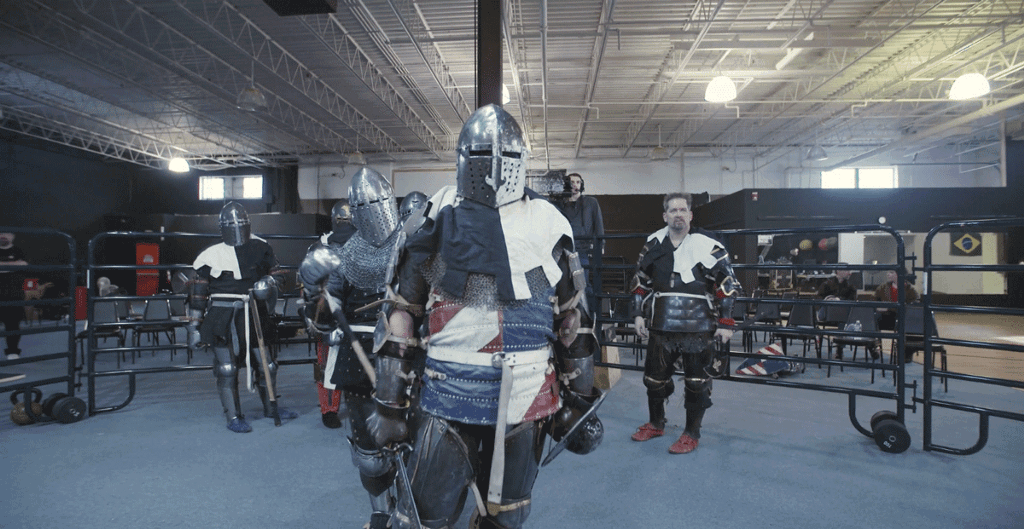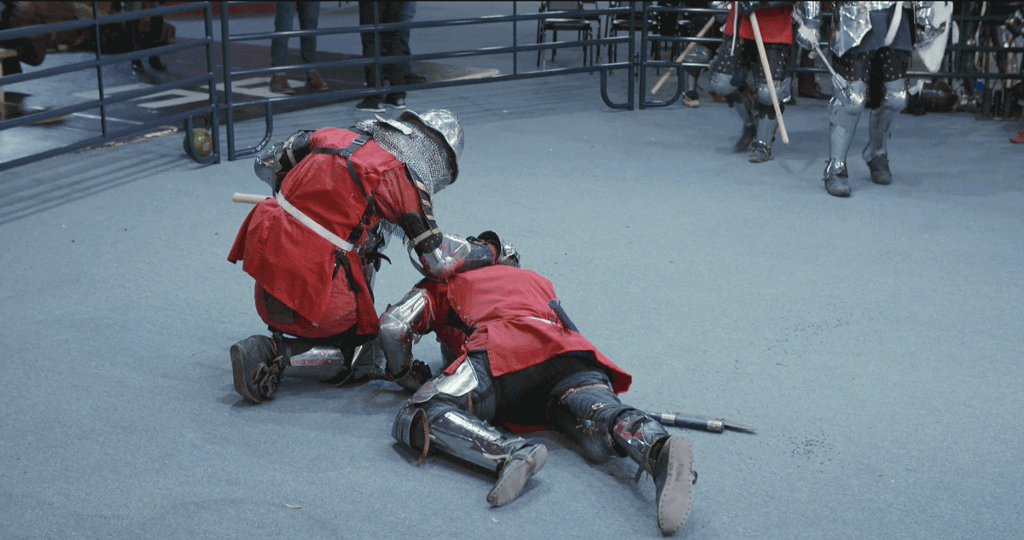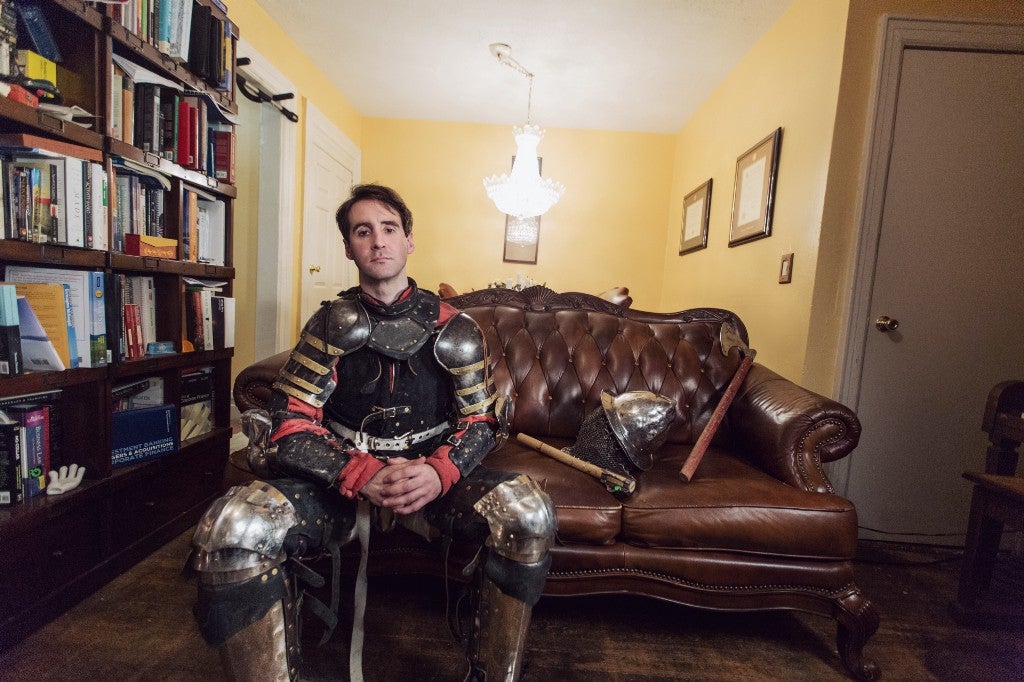Ever since a fellow player caught an ax to the nuts, Damion DiGrazia has become extra mindful of his junk.
It’s Saturday afternoon and the 35-year-old Wall Street management consultant is standing in a basement in Harlem with 25 other combat enthusiasts and history nerds in various states of undress, many of them attended by wives, friends and children. The room smells like a typical locker room — sweaty and dank — but instead of shoulder pads or hockey gloves littering the floor, there are gym bags full of gauntlets and shields, battle axes and broadswords.
With his dark head of thick Sicilian hair and warm brown eyes, DiGrazia looks more like your favorite uncle than a bloodthirsty modern Spartacus. It’s surprising that his sinewy 6-foot frame is capable of such violence.
Two hours from now, the New York Sentinels will face the Philadelphia Rhinos in a regular chapter match of the Armored Combat League (ACL). When the referee waves the yellow flag and yells, “Fight!”, each of the players — men in their mid-20s to mid-50s — will don up to 110 pounds of medieval-inspired armor and commence pounding the crap out of each other.
Part of a growing sport that began with small matches in Eastern Europe in 2010, the armored combat scene is now global; an annual world tournament hosts entrants from more than 22 nations. In the U.S. alone, there are more than 200 fighters on 10 regional teams. Fifty of the best are eligible each year to join the USA Knights, the national team that competes overseas. As of last year, women were allowed to fight in their own division.
The simple goal in ACL fighting is to knock down all the combatants from the opposing side. Stabbing with a sword is illegal, as is striking in certain areas, including the back of knees, neck and groin. Otherwise, anything goes. Most players use a combination of smashing blows, cross-checks, punches, trips and kicks. Think MMA meets the Knights of the Round Table.
At the international championships, each round of fighting lasts no more than eight minutes, and the victorious team must win two rounds. Up to 32 contestants from two teams charge at one another across an open field, armed with dulled-but-still-deadly weapons. Players lose teeth; they suffer compound fractures. At a recent tournament in New Jersey, a player ended up in the emergency room after taking two ax hits to the face. At the 2014 world tournament in Spain, one contestant’s finger was cut off in the heat of battle; in the spirit of feudalism, he awarded the digit to his foe in a Ziploc bag. Players on DiGrazia’s team started wearing steel cups, imported from a special armorer in the Ukraine, after an ACL player from New Hampshire got his plastic cup embedded into his flesh like a cookie cutter.
Dressed in black track pants and a tight black T-shirt, DiGrazia looks down at his crotch, the metal shining against his pants. “These things do exist,” he says. “People use them outside of funny little dungeons.” As DiGrazia continues to put on his armor, a process that can take some players up to 40 minutes, he notices a red smudge on his white belt. “That’s blood,” he says casually, as if pointing to some spaghetti sauce.
“There’s something inside of me that feels comfortable when I’m on the field and things are violent,” DiGrazia said a few days earlier. As a kid growing up in the then-rough Hell’s Kitchen neighborhood of Manhattan, DiGrazia was a “street rat,” known for getting into trouble and drinking too much. He didn’t initiate brawls, but he was always eager to jump in. In one fight, he says, he was almost stabbed with a broken bottle. In another, his head was repeatedly slammed into concrete. “Fear never really registered in my mind.”
At 20 he joined the U.S. Air Force, but instead of following his lifelong dream of becoming a fighter pilot, DiGrazia prioritized living with his girlfriend. She didn’t want him to see any action, so after boot camp, at his request, DiGrazia was sent to a base in Texas to train as an electrician. “Most of my life decisions have been centered around the women I’m with,” he says. “I try not to do that now.”
Three months later, DiGrazia broke his back while repairing a telephone pole. The injury spurred his addiction to alcohol and painkillers, and DiGrazia retired from the military in 2004. The pain was so bad he needed a cane to walk. The next year his girlfriend left him and he got a job as a bartender, drinking to excess every night. For a few months he had no apartment and slept on park benches, in stairwells and on subways, reading a Bible he stole from church to kill time. His father, disappointed in his alcoholic son, only let DiGrazia in his house to shave and shower between 8 and 8:30 a.m. In 2006, DiGrazia decided to sober up. He had rented a place a few months earlier and had just started taking college classes in hospitality management, which earned him $500 a month from the military. He had initially hoped to manage a bar, but his ambitions quickly became more scholarly; by 2014 he had an undergraduate degree in sociology from Columbia, a master’s degree in finance from Harvard and a job as management consultant for a top investment bank on Wall Street.
DiGrazia started to get in better physical shape as well. He took up running, and by 2010 was doing 100-mile ultramarathons, which take him between 25–30 hours to complete. He also trained in Krav Maga, the martial art developed for the Israeli army, but craved a more intense sport.

In 2012, DiGrazia went to a sword-fighting competition with a martial arts buddy and met a medieval combat fighter. DiGrazia’s enthusiasm was immediate: “This exists? I’m there.” Within a few months he had bought custom-made armor (eventually spending about $10,000 on a helmet, metallic leg braces and a leather jacket with metal plates) and fought in his first tournament. DiGrazia channeled his addictive, fearless personality into training and quickly rose within the ACL ranks. His lightweight frame made him an excellent flanker — flankers are the fastest players, who run out along the outside of the field to tackle opposing players. By 2014 DiGrazia had made the international team, become captain of the New York Sentinels and started offering instruction to new players.
DiGrazia estimates that about a quarter of the medieval fighters in the U.S. are armed forces veterans; a few are active military. “When we do international competitions, it’s like war,” says DiGrazia. Within the ACL, by contrast, players are more concerned with one another’s safety; players will extend a hand to an opponent kicked to the ground. Like soldiers, American medieval fighters follow a code of honor that includes loyalty, justice and teamwork; in battle a similar all-for-one mentality applies. “We shed blood with each other,” says DiGrazia. “Sometimes you have to sacrifice yourself for your comrade.”
At this afternoon’s battle — in a martial arts training center in a basement in Harlem that used to house a bathhouse — DiGrazia is visibly the thinnest of all 19 combatants, even when covered in 75 pounds of armor. In the 14th century his mace’s blunted flanges — which stick out like shark fins from its steel head — would have been sharp enough to pierce armor. DiGrazia tries out a two-handed mace for the first time, expecting he’ll have more striking power and a longer reach than with his regular one-handed weapon. He’ll be able to sneak up behind opponents, hook the wooden handle across their heads and pull them down to the ground.
Standing on the the tennis-court-sized platform where the battle will take place, DiGrazia and his team know they likely will not win. They have only been together for nine months, and the league has rounded out the roster of the opposing Philadelphia Rhinos (also a new team and lacking a full set of players) with some of the best and most experienced fighters in the league, from New Hampshire’s Nashua Knightmares. The team is known for training up to seven days a week, and for an aggressive fighting style that involves Jiu-Jitsu hits.

The master of ceremonies explains to the crowd that that each three-on-three game is worth one point; the first team to reach 11 wins. “Let’s hear it!” he shouts. The audience of 30 roars. “The field is yours,” he tells the combatants.
Three players from each team approach one another and quickly pair off into one-on-one fights: whacking each other with axes and maces, kicking with steel-toed boots, charging full-speed with their shields and punching with steel gauntlets. Nothing quite prepares you for the eruption of violent sound — like a hurricane sweeping through an industrial kitchen filled with pots and pans. The noise of weapons hitting armor is so loud that a guy walks in from the street to see what the hell is going on.
Each game is a short, confusing spurt of violence that lasts anywhere from 12 seconds to three minutes. The only slow moments are when the fighters get locked in clinches. By the fourth round, the Sentinels are down 2–6, but DiGrazia hangs onto his confidence as he twirls his mace and rushes toward Evan Ringo, a 28-year-old from the Nashua Knightmares, whose weapon of choice is a dulled ax.

DiGrazia cocks his mace like a baseball bat and lunges towards Ringo’s helmet. Ringo blocks the shot with his steel-plated forearm, and grabs the staff of DiGrazia’s mace with one hand, tying him up.
Ringo nails DiGrazia three times on the side of his head with his ax, adding more dents to a helmet that’s already one of the most dented in the league, and kicks him into a corner of the wooden fence. Hold on, DiGrazia tells himself. Soon Ringo will be tired out.
A Rhino named Ray Witte then hits DiGrazia twice on the helmet with his ax, so hard that his head whips to the right. The audience gasps. DiGrazia can feel his brain rock, but help is on the way.
A Sentinel launches himself in the air, kicks Witte from behind, and smashes him with his sword. DiGrazia, who’s still backed into the corner, takes advantage of his opponent’s sudden weakness. He becomes that street rat who jumps into fights, that adrenaline junkie who risks his life for the high and hooks his right leg around Witte’s left, shoving him to the ground with his shoulder — a move he likens to Bruce Lee’s famous one-inch punch.
Victory for the Sentinels, at least for this round.
Once again the basement turns into a giant locker room, humid and full of residual electricity, the knights attended by the serfs, maidens and urchins of their immediate families. Some of the players gather around a television to watch a replay of the match. Though in the end the Rhinos won 11–7, there’s no tension between the winners and losers — they all see themselves as part of Team USA and today’s battle as just a training drill.
DiGrazia’s helmet comes off, revealing bits of sweaty hair attached to his flushed face. He is unfazed by the ax blows to his head. “It’s like eating breakfast,” he says of the fight. “It’s become a regular part of my life.” For DiGrazia, medieval fighting feels no more dangerous than a trip to the gym.
As a sensation-seeker, DiGrazia will probably always feel comfortable amid barbaric chaos. The fearless streak that caused him to jump into fights and pull dangerous stunts like climbing atop the Brooklyn Bridge is still strong as he approaches 40 and wears a suit to work every day. But now his inner street rat is protected by armor and dedicated to winning international competitions. For DiGrazia, medieval fighting is more than just a hobby: It’s a lesson that violence does not have to be savage.
“When there’s a guy breaking a bottle and trying to stab me or I’m getting jumped by guys at a park who aren’t concerned about my well-being — that’s real violence,” he says. “While medieval fighting I might pop a shoulder or bleed, but in the end it’s brotherly love.”
Angelina Chapin is an editor at The Huffington Post. Her previous MEL piece was on the very swole world of teenage bodybuilders.
More from MEL Films:
- A Wild, Wild West Response to the Syrian Refugee Crisis
- A Couple’s Guide to Living on a Boat in New York in Winter
- Bright Lights, 18 Wheelers
